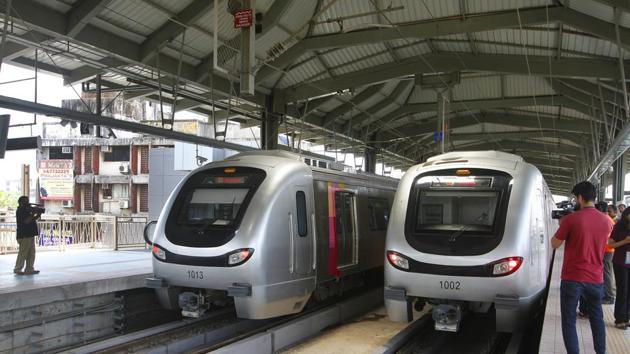Life after a Metro: Less traffic, but more CO2
IIT-B STUDY: Most shifted from buses; CO2 up as Metro consumes more power
The city’s first Metro line has decreased traffic congestion and greenhouse gas (GHG) emissions along the congested Ghatkopar-Andheri road corridor, but the electricity generation for the operation is releasing three times the carbon dioxide (CO2) that has been prevented from being released because of lower road traffic.

This is because a majority who travel by the Metro have switched from other modes of public transport like buses, which release less greenhouse gases per capita compared to private vehicles. Also, a Metro operation is more energy intensive compared to buses and other road vehicles.
An analysis done by the Indian Institute of Technology-Bombay (IIT-B) has revealed that the 11.4 km-long Versova-Andheri-Ghatkopar Metro line, which now carries around 3,12,000 passengers daily has helped reduced 22.7 tonnes of CO2 emissions a day because commuters have shifted from buses and other road vehicles. But the Metro’s operation releases 75.6 tonnes of CO2 every day – though these emissions are at the place where the electricity is generated. This is because, the Metro consumes 90,000 units of electricity – 50,000 units for electric traction, while the remaining 40,000 units in non-traction electricity consumption that includes lights, air conditioning, lift, escalators and shops. With approximately 57% electricity in India from coal power plants, researchers said GHG emissions are occurring at source, in line with a 2008 study which highlighted that rail transit consumes more energy/passenger mile and also emits more GHG emissions than any other passenger vehicle.
On the positive side, however, 0.30 tonnes a day of carbon monoxide (CO), 0.15 tonnes a day of hydrocarbons (HC), 0.17 tonnes a day of oxides of nitrogen (NOx) and 0.01 tonnes a day of particulate matter (PM) that gets emitted by vehicles is avoided as a result of shift to Metro. Mumbai Metro has also saved commuters between 20 minutes and 50 minutes of their travel time.
“In Mumbai, 75% people are dependent on public modes of transportation. Therefore, there has not been a significant decrease in carbon dioxide emissions because the majority that travels by the metro has switched from another mode of public transport. A second reason for the increase in emissions is the non-traction energy used in the Metro,” said professor Munish Chandel, Centre for Environmental Science and Engineering, IIT-B.
Chandel said the proposed seven metro lines and four that are currently under construction will increase the number of commuters and result in a net reduction in emissions.
“Once the projected Metro 1 ridership increases to 8.82 lakh in 2031, reduction in CO2 emission from modal shift would be higher than the emissions from the Metro. Once the whole Metro network is developed, there will be more CO2 reduction from the Metro,” he said.
The Versova-Andheri-Ghatkopar Metro Line 1 implemented in 2014 is an elevated corridor constructed on the most congested route, and provided connectivity for eastern and western suburbs to western and central railway. Most commuters today board and alight from Ghatkopar, Andheri and Sakinaka stations.
With an average ridership of between 26,000 and 28,000 commuters per km daily, the Metro with a maximum speed of 50km an hour consumes around 2.26 million units of electricity a month.
Researchers said unlike Delhi where commuters swapped the road with the Delhi Metro rail, the situation in Mumbai is different.
“Operating a Metro is highly energy intensive as compared to local trains or buses, and therefore cannot be an environmentally sustainable mode of transport,” said Vivek Pai, transport planner, Mumbai Mobility Forum, a citizens’ group. “Even if some people with private vehicles opt for the Metro and free space on the roads, there will always be a different set that will get their vehicles out and congest the roads.”
Stay updated with all the Breaking News and Latest News from Mumbai. Click here for comprehensive coverage of top Cities including Bengaluru, Delhi, Hyderabad, and more across India along with Stay informed on the latest happenings in World News.
Stay updated with all the Breaking News and Latest News from Mumbai. Click here for comprehensive coverage of top Cities including Bengaluru, Delhi, Hyderabad, and more across India along with Stay informed on the latest happenings in World News.






